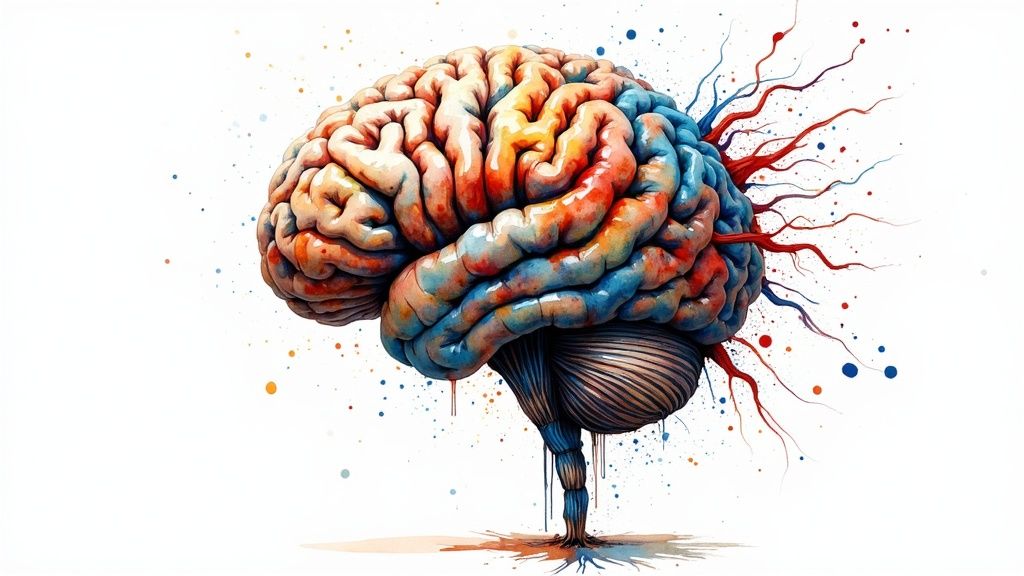What Is Generative Artificial Intelligence? A Complete Guide to AI's Creative Breakthroughs
Generative AI marks a fundamental shift in how artificial intelligence works. While traditional AI systems could only analyze existing information, generative AI can create entirely new content from scratch. Think of it this way: instead of just being able to identify a cat in a photo, generative AI can draw its own unique image of a cat - even one playing a piano or dancing - based on what it has learned. This ability to create original content opens up exciting possibilities across many fields. To really grasp how generative AI achieves this, let's explore the key concepts behind it.
How Generative AI Learns and Creates
At its foundation, generative AI works by studying massive collections of data. When trained on thousands of images, for instance, the system begins to understand the basic building blocks that make up different types of pictures - the patterns, textures, and relationships between elements. But it goes beyond simple memorization. The AI develops an understanding of the fundamental principles behind image creation, similar to how an artist learns composition and technique. This deep learning allows it to generate completely original images that follow these learned principles while being entirely unique.
Different Types of Generative AI Models
Generative AI isn't a one-size-fits-all technology - different models excel at different creative tasks. Some specialize in writing, producing everything from poetry to computer code. Others focus on creating images, generating both photorealistic scenes and abstract artwork. There are even models designed specifically for audio, able to compose music or recreate human voices. Each type demonstrates the flexibility of this technology to tackle various creative challenges. For more insights into how these models impact different industries, check out our guide on AI Literacy for Management and Business Educators.
Key Characteristics of Generative AI
Several essential features make generative AI stand out from other AI systems. First is its creative ability - it doesn't just remix existing content but generates genuinely new material. The technology relies on sophisticated neural networks that process information in ways similar to the human brain, allowing for nuanced and complex outputs. Another interesting aspect is the element of randomness built into these models. This controlled unpredictability helps the AI explore different possibilities and occasionally produce surprising results, much like human creativity. The combination of learned patterns and careful randomness makes generative AI particularly good at coming up with new ideas and solutions.
The Journey from Rule-Based Systems to Creative AI

The story of generative AI begins in 1956 at the historic Dartmouth Summer Research Project, where researchers first explored the possibility of machines engaging in creative processes. This landmark gathering marked the birth of AI as a field and set the stage for decades of advancement. In 1958, the development of the perceptron - an early neural network - provided the first building blocks for what would eventually become modern generative AI systems.
Early Steps Toward Generative AI: Chatbots and Beyond
One of the first major breakthroughs came with ELIZA, a chatbot created in the mid-1960s. Though basic by today's standards, ELIZA showed that computers could engage in simple conversations by following programmed patterns to generate responses. This early success inspired researchers to develop increasingly sophisticated chatbots that could better understand context and produce more natural dialogue. These incremental improvements laid important groundwork for modern natural language processing.
The Deep Learning Revolution: VAEs and GANs
The 2010s brought rapid progress as increased computing power enabled deep learning techniques. In 2013, researchers introduced Variational Autoencoders (VAEs), which could analyze patterns in existing data to generate new, similar examples. For instance, after studying thousands of cat photos, a VAE could create entirely new cat images by combining learned features in novel ways. An even bigger advance came in 2014 with Generative Adversarial Networks (GANs). GANs work by pitting two neural networks against each other - one creates fake data while the other tries to spot the fakes. This competition drives both networks to improve, resulting in increasingly realistic synthetic images, videos, and other content.
Transformers and the Rise of Large Language Models
The next major leap forward came in 2017 with transformer architectures, which excel at processing sequential data like text. This breakthrough enabled OpenAI to develop their GPT (Generative Pre-trained Transformer) series of models. GPT and its successors like GPT-3 and GPT-4 demonstrated remarkable abilities in translation, summarization, and creative writing by learning patterns from massive text datasets. Other companies followed with their own large language models - Google released Gemini and Meta launched Llama. These powerful AI systems are now being integrated into countless applications, opening up new possibilities for human-AI interaction and collaboration. As research continues, large language models keep pushing the boundaries of what AI can achieve.
Understanding the Engine Behind Creative AI

Let's dive into what makes generative AI work under the hood. Understanding these core technologies helps us better grasp both the incredible capabilities and real limitations of these systems. We'll explore how they learn from data, recognize patterns, and create new content.
Neural Networks: The Foundation of Generative AI
At their heart, generative AI systems use neural networks - computer systems that take inspiration from how our brains work. These networks contain layers of connected nodes, like neurons, that pass information between each other. Each connection has a specific strength or "weight" that gets fine-tuned as the system learns from examples. For instance, when learning to recognize images, the network first picks up basic elements like edges, then builds up to identifying more complex shapes and eventually complete objects. This layered learning approach is key to how these AI systems understand and generate content.
Different Architectures for Different Tasks
Different types of neural networks excel at different tasks. Two important types are Variational Autoencoders (VAEs) and Generative Adversarial Networks (GANs). VAEs are great at learning the building blocks of data to generate new examples. Think of training a VAE on thousands of handwritten numbers - it learns the essential qualities of each digit and can then create brand new, realistic-looking numbers based on what it learned.
GANs work differently, using two competing parts: one that creates new content and another that tries to spot fakes. As these two parts compete, they both get better - the creator makes more convincing content while the detector gets sharper at catching flaws. This back-and-forth has led to impressive results in creating realistic images, videos, and even music that can be hard to distinguish from the real thing.
Transformers: Powering Language Models
The latest breakthrough has been transformer networks, which form the basis of advanced language models like GPT-3 and GPT-4. These systems are especially good with text because they use "attention" - the ability to focus on different parts of the input when creating output. This helps them understand context and connections between words, leading to their skill at tasks like translation, summarization, and creative writing. Thanks to this ability to grasp language nuances, transformers have become essential for text-based AI applications, and ongoing improvements keep expanding what's possible.
Real-World Success Stories and Implementation Strategies

Companies are now putting generative AI to work and seeing real business results. Let's explore some specific examples of organizations successfully implementing this technology to improve their operations, spark creativity, and solve complex challenges.
Streamlining Operations with Generative AI
Smart companies are using AI to handle routine tasks so their employees can focus on higher-value work. For instance, customer service teams are implementing AI chatbots to answer common questions, which allows human agents to devote their time to more nuanced customer issues. Marketing departments are also seeing benefits by using AI to create personalized content that resonates with individual customers. This strategic shift in resources has led to both improved efficiency and higher customer satisfaction rates.
Enhancing Creativity and Innovation
AI is proving to be a valuable creative partner across industries. Design teams are using it to quickly generate multiple concept variations based on initial ideas, allowing them to explore many more possibilities than traditional methods would allow. As a result, companies can bring new products and design solutions to market faster. For more insights on maximizing AI's creative potential, check out: How to master AI for your business.
Solving Complex Challenges With AI-Powered Solutions
The impact of generative AI extends into highly specialized fields. In healthcare research, teams are using it to speed up drug discovery by generating and analyzing new molecular structures. Engineers are applying AI to optimize designs for everything from aircraft engines to building systems, finding ways to improve performance while reducing costs. These applications show how AI can tackle previously intractable problems in entirely new ways.
Lessons Learned: Successes and Failures
The path to successful AI implementation isn't always smooth. The most important lesson from early adopters is that data quality matters immensely - AI systems can only be as good as the information they're trained on. Organizations must also be clear-eyed about what AI can and cannot do. Setting realistic expectations and having a solid understanding of the technology's limitations is crucial. Just as important is maintaining strong ethical standards throughout implementation. As these systems become more capable, responsible use and careful oversight become increasingly vital.
Understanding Ethics And Challenges In Creative AI
The rise of AI-powered creative tools brings both exciting possibilities and significant ethical concerns that need careful consideration. As these systems grow more advanced, we must proactively address key issues around fairness, rights, and authenticity to ensure this technology benefits society while minimizing potential downsides.
Reducing Bias In AI Systems
A major challenge with AI systems is their tendency to reflect and magnify biases present in their training data. When an AI learns from datasets that contain social prejudices, those same biases show up in what it creates. For example, if the training images mostly show men in executive roles, the AI will likely generate more male CEOs in response to related prompts. Fixing this requires several steps: carefully selecting diverse and balanced training data, continuously monitoring outputs for bias, and developing new technical approaches to make the underlying algorithms more fair and inclusive.
Sorting Out Rights And Ownership
The question of who owns AI-generated content remains unclear and complex. When an AI system creates a song or piece of art, does the copyright belong to the AI itself, the company that made it, or the person who gave it instructions? This legal uncertainty needs new frameworks to properly address. There are also serious concerns about AI being used to create misleading deepfake content that erodes trust. For more insights on navigating these issues responsibly, check out our guide on How to master AI for strategic decision-making.
Building Trust Through Ethical Practices
Successfully handling these challenges requires taking action on multiple fronts. Companies using AI need clear ethical guidelines from the start - covering everything from how they collect data to how they develop and use their AI systems. Being transparent is also critical, so people know when they're interacting with AI-created content. And as AI technology keeps advancing, we need to regularly review and update our ethical approaches.
Learning From Real-World Examples
Some companies are already leading the way in addressing AI ethics proactively. They're auditing their training data to spot and fix biases before they affect outputs. Others are exploring new ways to handle rights and licensing for AI-generated work. These early efforts show growing awareness that ethics need to be a priority in AI development. By focusing on responsible practices, organizations can help ensure AI technology creates real benefits while avoiding potential problems.
Preparing for Tomorrow's Creative Revolution
As AI tools and capabilities grow more sophisticated each day, creative professionals need to understand and adapt to these changes. The way we create, design, and produce content is fundamentally shifting - presenting both opportunities and challenges for those willing to learn and experiment with these new technologies.
Beyond the Horizon: Emerging Trends in Generative AI
The world of generative AI is becoming more accessible and powerful. What was once limited to research labs is now available through easy-to-use platforms like ChatGPT and Midjourney. This shift means that creative professionals at all levels can now experiment with AI-assisted content creation.
The quality of AI outputs continues to improve dramatically. Recent image generation models can create stunningly realistic visuals, while text models can adapt to different writing styles with remarkable accuracy. For instance, AI can now generate photorealistic product renders, architectural visualizations, and marketing copy that closely matches a brand's voice and tone.
The Impact on Industries: Reimagining Creative Workflows
These advances are changing how work gets done across creative fields. Marketing teams can now quickly generate and test multiple versions of campaigns. Film and TV productions use AI to create special effects and assist with scriptwriting. Product designers and architects can rapidly prototype different concepts, getting to better solutions faster.
The key is finding the right balance between human creativity and AI assistance. When used thoughtfully, these tools can handle time-consuming technical tasks while letting humans focus on high-level creative direction and strategic decisions.
Strategies for the Future: Embracing the AI-Powered Creative Landscape
To thrive in this evolving environment, creative professionals should focus on two key areas. First, develop a solid understanding of AI tools and their capabilities through hands-on experimentation. Learn the fundamentals of prompt engineering - the art of giving AI clear instructions to get desired results.
Second, look for ways AI can enhance rather than replace human creativity. The most successful approaches combine uniquely human skills like emotional intelligence and original thinking with AI's ability to quickly generate and iterate on ideas. This collaboration between human and machine often leads to more interesting and innovative creative work.
Want to harness the power of AI for your business? Dixon Humphreys offers expert consultancy and training services to help you navigate the world of artificial intelligence. Visit https://dixonhumphreys.com to learn more.

